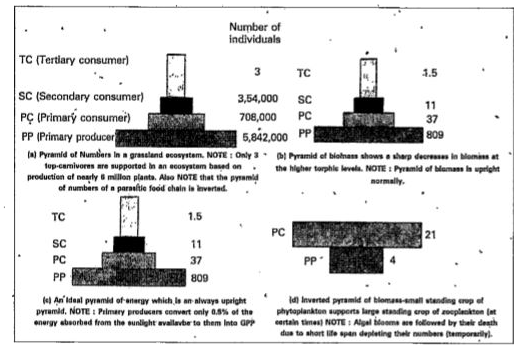Define ecological pyramids and describe with examples pyramids of number and biomass.Solution in Telugu
It is a graphical representation of the trophic structure and function of an ecosystem. The base of each pyramid represents the producers of the first trophic level, while the apex represents the tertiary or top level/top order consumers. The three types of ecological pyramids that are usually studied are (a) pyramid of number (b) pyramid of biamass and (c) pyramid of energy. These pyramids were first represented by Elton, hence the name ELTONIAN pyramids / Ecological pyramids.
Any calculations of energy content, biomass or numbers has to include all organisms at that trophic level. No generalizations we make will be true if we take only a few individuals of any trophic level into account. In most ecosystems, all the pyramids - of numbers, energy and biomass are uprights. i.es, producers are more in number and biomass than the herbivores, and herbivores are more in number and biomass than the carnivores. Also energy (available) at a lower trophic level is always more than that at a higher level. .
There are exceptions to this generalization. In the case of a parasitic food chain, the pyramid of numbers is inverted. A large tree (single producer) may support many herbivores like squirrels and fruit eating birds. On these herbivores many ectoparasites such as-ticks, mites and.lice (secondary consumers) may live. These secondary consumers may support many more top level consumers and also the hyperparasites. Thus in each trophic level from the bottom to the top, the numbers of organisms increase and forin an .inverted pyramid. of numbers.
The pyramid of biomass in sea is also generally inverted because the biomass of fishes far exceeds that of phytoplankton.

Topper's Solved these Questions
- ECOLOGY AND ENVIRONMENT BOOK - VIKRAM PUBLICATION ( ANDHRA PUBLICATION)CHAPTER - ECOLOGY AND ENVIRONMENT EXERCISE - LONG ANSWER QUESTIONS
7 Videos
- ECOLOGY AND ENVIRONMENT BOOK - VIKRAM PUBLICATION ( ANDHRA PUBLICATION)CHAPTER - ECOLOGY AND ENVIRONMENT EXERCISE - IMPORTANT QUESTIONS
45 Videos
- ECOLOGY AND ENVIRONMENT BOOK - VIKRAM PUBLICATION ( ANDHRA PUBLICATION)CHAPTER - ECOLOGY AND ENVIRONMENT EXERCISE - IMPORTANT QUESTIONS
45 Videos
- ECOLOGICAL ADAPTATION, SUCCESSION AND ECOLOGICAL SERVICESBOOK - VIKRAM PUBLICATION ( ANDHRA PUBLICATION)CHAPTER - ECOLOGICAL ADAPTATION, SUCCESSION AND ECOLOGICAL SERVICESEXERCISE - TEXTUAL EXERCISE
8 Videos
- HISTOLOGY AND ANATOMY OF FLOWERING PLANTS BOOK - VIKRAM PUBLICATION ( ANDHRA PUBLICATION)CHAPTER - HISTOLOGY AND ANATOMY OF FLOWERING PLANTS EXERCISE - IMPORTANT QUESTIONS
7 Videos
Similar Questions
Write an essay on temperature as an ecological factor
View SolutionDefine the term "ecology" and its branches.
View SolutionDefine the term "ecology" and its branches.
View SolutionCategorise the following plants into hydrophytes halophytes, mesophytes and xerophytes and give reasons.
a) Salvinia b) Opuntia c) Rhizophora d) Mangifera
View SolutionWhy are xylem and phloem called complex tissues?
View SolutionIdentify the type of the given ecological pyramid and give one example each of pyramid of number and pyramid of biomass in such cases.
View SolutionDefine ecological pyramid? Describe pyramid of energy flow with a example.
View SolutionDefine ecological pyramids and explain with examples the pyramids of biomass or biomass and number.
View SolutionDefine ecological pyramids and describe with examples the different types.
View SolutionDefine ecological pyramids and describe numerical pyramids and tuna pyramids as examples. (TQ)
View SolutionIdentify the type of the given ecological pyramid and give one example each of pyramid of number and pyramid biomass in such case.

View SolutionDefine ecological pyramids and describe the pyramid of number .
View SolutionDescribe ecological pyramid of biomass .
View Solutionসংখ্যার পিরামিড ও বায়োমাসের পিরামিড়ের উদাহরণসহ বিবরণ দাও ।
View SolutionDescribe the pyramid of numbers and the pyramid of biomass with examples.
View Solutionসংখ্যার পিরামিড ও বায়োমাসের পিরামিড়ের উদাহরণসহ বিবরণ দাও ।
View Solution
